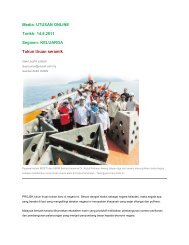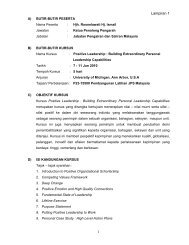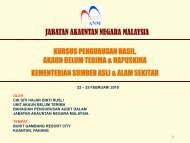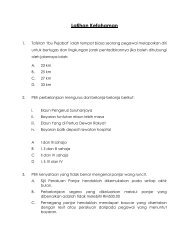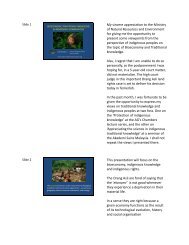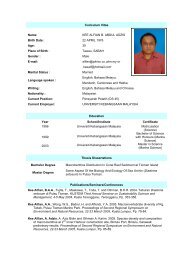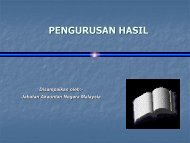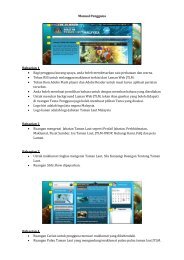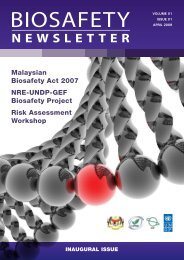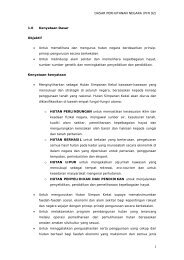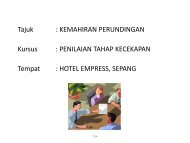Scleractinian Coral diversity in Kepulauan Sembilan, Perak
Scleractinian Coral diversity in Kepulauan Sembilan, Perak
Scleractinian Coral diversity in Kepulauan Sembilan, Perak
You also want an ePaper? Increase the reach of your titles
YUMPU automatically turns print PDFs into web optimized ePapers that Google loves.
<strong>Scleract<strong>in</strong>ian</strong> <strong>Coral</strong> <strong>diversity</strong> <strong>in</strong><br />
<strong>Kepulauan</strong> <strong>Sembilan</strong>, <strong>Perak</strong><br />
Lau C.M. 1 , Affendi Y.A. 1 , Jillian Ooi 2 , Yuen Y.S. 3 , Yusuf Y. 4<br />
1<br />
Institute of Biological Sciences, Universiti Malaya<br />
2<br />
Department of Geography, Universiti Malaya<br />
3<br />
Institute of Ocean & Earth Sciences, Universiti Malaya<br />
4<br />
Universiti Malaysia Terengganu
N<br />
P. Pangkor<br />
Lumut<br />
PERAK<br />
<strong>Kepulauan</strong><br />
<strong>Sembilan</strong><br />
Sungai <strong>Perak</strong><br />
10.6 km
N<br />
Day 1 (12 May 2012)<br />
Day 2 (13 May 2012)<br />
<strong>Kepulauan</strong><br />
<strong>Sembilan</strong><br />
Day 3 (14 May 2012)<br />
3053 m
(Photos: Affendi YA)<br />
SCUBA<br />
Div<strong>in</strong>g<br />
•4 divers<br />
•free swimm<strong>in</strong>g observation<br />
•50 – 60 m<strong>in</strong>utes; 6 - 23 m<br />
<strong>Coral</strong><br />
Identification<br />
•Identified <strong>in</strong> situ, if possible<br />
•Photo & samples taken for identification<br />
us<strong>in</strong>g Veron & Stafford-Smith (2000)<br />
(Photos: Affendi YA)<br />
Live coral<br />
cover<br />
•Visual estimation, %<br />
Rapid<br />
Assessment<br />
• Spot for <strong>in</strong>dicators,<br />
diseases, bleach<strong>in</strong>g, stress
P. Agas (NW)<br />
Site description:<br />
• Turbid water; low visibility ~ 4 m<br />
• Max depth ~ 11.3 m; Average ~ 6.4 m<br />
• Live coral cover ~ 40%, mostly encrust<strong>in</strong>g<br />
growth form<br />
• High number of sea urch<strong>in</strong><br />
<strong>Coral</strong> genera:<br />
• Acropora*<br />
• Diploastrea*<br />
• Ech<strong>in</strong>ophyllia<br />
• Favia<br />
• Favites<br />
• Fungia<br />
• Goniastrea<br />
• Goniopora<br />
• Pavona<br />
• Pocillopora*<br />
• Porites*<br />
• Symphyllia*<br />
• Turb<strong>in</strong>aria*<br />
• Tubastrea*<br />
(Photo: Lau CM) (Photo: Lau CM) (Photo: Lau CM)
(Photo: Affendi YA)<br />
(Photo: Lau CM)<br />
(Photo: Affendi YA)<br />
(Photo: Affendi YA)
(Photo: Lau CM)<br />
• Disease<br />
• Bleach<strong>in</strong>g<br />
• Sedimentation<br />
(Photo: Lau CM)<br />
(Photo: Lau CM)<br />
(Photo: Lau CM)
Site description:<br />
P. Nipis (SE)<br />
• Turbid water; low visibility ~ 4 m<br />
• Max depth ~ 7.0 m; Average ~ 4.2 m<br />
• Live coral cover ~ 60%<br />
<strong>Coral</strong> genera:<br />
•Acropora*<br />
•Diploastrea*<br />
•Euphyllia<br />
•Favia<br />
•Favites<br />
•Fungia<br />
• Goniastrea<br />
• Pocillopora*<br />
• Porites*<br />
• Symphyllia*<br />
• Turb<strong>in</strong>aria*<br />
• Tubastrea*<br />
(Photo: Affendi YA)<br />
(Photo: Affendi YA)<br />
(Photo: Lau CM)<br />
(Photo: Lau CM)
(Photo: Lau CM)<br />
(Photo: Affendi YA)<br />
(Photo: Affendi YA)<br />
(Photo: Affendi YA)<br />
(Photo: Affendi YA)
(Photo: Lau CM)<br />
•Disease<br />
•Sedimentation<br />
•Bleach<strong>in</strong>g<br />
•Bioerosion<br />
(Photo: Lau CM)<br />
(Photo: Lau CM)<br />
(Photo: Affendi YA)
Tukun Jepun (N)<br />
Site description:<br />
• Very turbid water; very low visibility
P. Lalang (SW)<br />
Site description:<br />
• Turbid water; low visibility 7 - 8 m<br />
• Max depth ~ 6.4 m; Average ~ 4.2 m<br />
• Live coral cover ~ 60%, mostly tabular and<br />
plate-like corals<br />
• Many bleached Porites sp.<br />
• High number of sea urch<strong>in</strong><br />
<strong>Coral</strong> genera:<br />
• Acropora*<br />
• Diploastrea*<br />
• Ech<strong>in</strong>ophyllia<br />
• Favia<br />
• Favites<br />
• Fungia<br />
• Goniopora<br />
• Pavona<br />
• Pocillopora*<br />
• Porites*<br />
• Symphyllia*<br />
• Turb<strong>in</strong>aria*<br />
• Tubastrea*<br />
(Photo: Lau CM)<br />
(Photo: Lau CM)<br />
(Photo: Lau CM)
(Photo: Lau CM)<br />
(Photo: Affendi YA)<br />
(Photo: Lau CM)<br />
(Photo: Lau CM)<br />
(Photo: Lau CM)<br />
(Photo: Lau CM)<br />
(Photo: Lau CM)
(Photo: Lau CM)<br />
(Photo: Lau CM)<br />
(Photo: Lau CM)<br />
• Disease<br />
• Bleach<strong>in</strong>g<br />
• Sedimentation<br />
• Fish bite<br />
• Competition<br />
(Photo: Lau CM)<br />
(Photo: Lau CM)
Site description:<br />
P. Saga (SE)<br />
•Turbid water; low visibility ~ 4 m<br />
•Max depth ~ 9.7 m; Average ~ 6.7 m<br />
•Live coral cover ~ 50%, patchy reef<br />
•High cover of sea anemone but low <strong>diversity</strong><br />
<strong>Coral</strong> genera:<br />
• Acropora*<br />
• Coeloseris<br />
• Diploastrea*<br />
• Favia<br />
• Fungia<br />
• Pocillopora*<br />
• Porites*<br />
• Symphyllia*<br />
• Turb<strong>in</strong>aria*<br />
• Tubastrea*<br />
(Photo: Lau CM)<br />
(Photo: Lau CM)<br />
(Photo: Lau CM)
(Photo: Affendi YA)<br />
(Photo: Affendi YA)<br />
(Photo: Affendi YA) (Photo: Affendi YA) (Photo: Affendi YA)
(Photo: Lau CM)<br />
(Photo: Affendi YA)<br />
• Disease<br />
• Bleach<strong>in</strong>g<br />
• Discarded<br />
fish<strong>in</strong>g gear<br />
• Competition<br />
(Photo: Affendi YA)<br />
(Photo: Affendi YA)
Site description:<br />
P. Rumbia (SE)<br />
• Turbid water; low visibility 8-9 m<br />
• Max depth ~ 14.9 m; Average ~ 6.1 m<br />
• Live coral cover ~ 50%<br />
• Many Acropora sp.<br />
(Photo: Affendi YA)<br />
<strong>Coral</strong> genera:<br />
•Acropora*<br />
•Diploastrea*<br />
•Favites<br />
•Hydnophora<br />
•Mycedium<br />
• Pocillopora*<br />
• Porites*<br />
• Symphyllia*<br />
• Turb<strong>in</strong>aria*<br />
• Tubastrea*<br />
(Photo: Lau CM) (Photo: Lau CM) (Photo: Lau CM)
(Photo: Affendi YA)<br />
(Photo: Affendi YA)<br />
(Photo: Affendi YA)<br />
(Photo: Affendi YA)<br />
(Photo: Affendi YA)
(Photo: Lau CM)<br />
• Bioerosion (Photo: Affendi YA)<br />
• Disease<br />
• Sea anemone <strong>in</strong>festation<br />
• Discarded fish<strong>in</strong>g gear<br />
(Photo: Affendi YA)<br />
(Photo: Affendi YA)<br />
(Photo: Lau CM)
Site description:<br />
P. Buloh (E)<br />
• Turbid water; low visibility 7-8 m<br />
• Max depth ~ 11.3 m; Average ~ 6.1 m<br />
• Live coral cover ~ 60%, patchy reef<br />
• Cyanobacteria layer on reef bottom<br />
• Sponges overgrown corals<br />
• Mucus/membrane layer on massive Porites<br />
<strong>Coral</strong> genera:<br />
• Asteopora *<br />
• Diploastrea*<br />
• Fungia<br />
• Goniastrea<br />
• Hydnophora<br />
• Pavona<br />
• Pocillopora*<br />
• Porites*<br />
• Symphyllia*<br />
• Turb<strong>in</strong>aria*<br />
• Tubastrea*<br />
(Photo: Lau CM) (Photo: Lau CM) (Photo: Lau CM)
• Disease<br />
• Sedimentation<br />
• Competition<br />
• Cyanobacteria<br />
overgrowth<br />
(Photo: Lau CM)<br />
(Photo: Lau CM)<br />
(Photo: Lau CM)<br />
(Photo: Lau CM)
Site description:<br />
White Rock (W)<br />
• Turbid water; visibility varies due to<br />
changes <strong>in</strong> water depth<br />
• Max depth ~ 23.4 m; Average ~ 13.1 m<br />
• Live coral cover ~ 25%, wall div<strong>in</strong>g<br />
• Many Tubastrea sp. and whip corals<br />
• High number of sea urch<strong>in</strong><br />
<strong>Coral</strong> genera:<br />
• Acropora*<br />
• Goniopora<br />
• Hydnophora<br />
• Favia<br />
• Favites<br />
• Mycedium<br />
• Turb<strong>in</strong>aria*<br />
• Tubastrea*<br />
(Photo: Lau CM)<br />
(Photo: Lau CM)<br />
(Photo: Lau CM)
(Photo: Lau CM)<br />
(Photo: Lau CM)<br />
(Photo: Lau CM)<br />
(Photo: Lau CM)<br />
(Photo: Lau CM)
Summary<br />
17 species<br />
4 genera<br />
14 genera<br />
35 species<br />
N<br />
12 genera<br />
30 species<br />
<strong>Coral</strong><br />
genera<br />
Fish<br />
species<br />
40 species<br />
10 genera<br />
13 genera<br />
46 species<br />
8 genera<br />
37 species<br />
10 genera<br />
28 species<br />
<strong>Kepulauan</strong><br />
<strong>Sembilan</strong><br />
11 genera<br />
44 species<br />
3053 m
Summary<br />
• <strong>Kepulauan</strong> <strong>Sembilan</strong> is a turbid area with low<br />
underwater visibility and strong currents<br />
• Low <strong>diversity</strong> of scleract<strong>in</strong>ian corals - 19 genera<br />
• Most coral genera consists of stress-tolerant types<br />
that can withstand high sedimentation, high<br />
bioerosion, low light levels and high turbidity<br />
• Possible nutrient <strong>in</strong>flux or runoff from river or from<br />
coastal development<br />
• Low <strong>diversity</strong> of fish species - 99 species
Acknowledgement<br />
• Jabatan Taman Laut Malaysia<br />
• Quiver Dive Team, Lumut<br />
• Innovasi Samudra Sdn. Bhd.<br />
• All volunteers from Universiti Malaya and Universiti<br />
Sarawak Malaysia<br />
• SEABUDS



